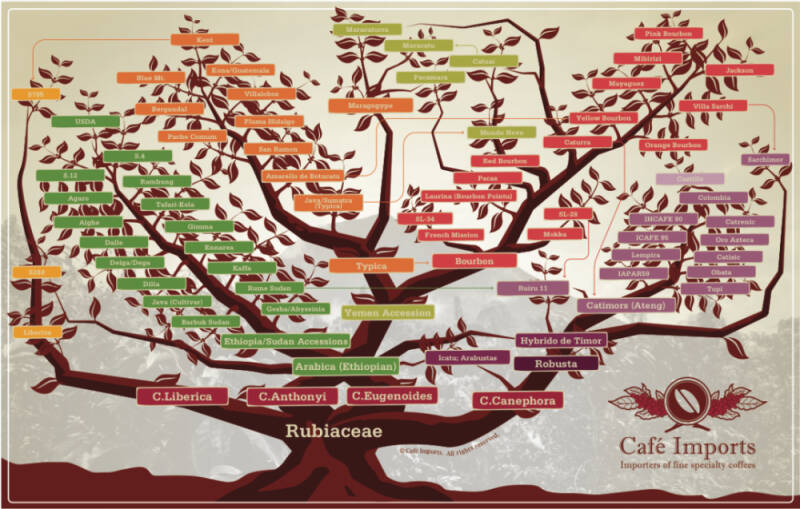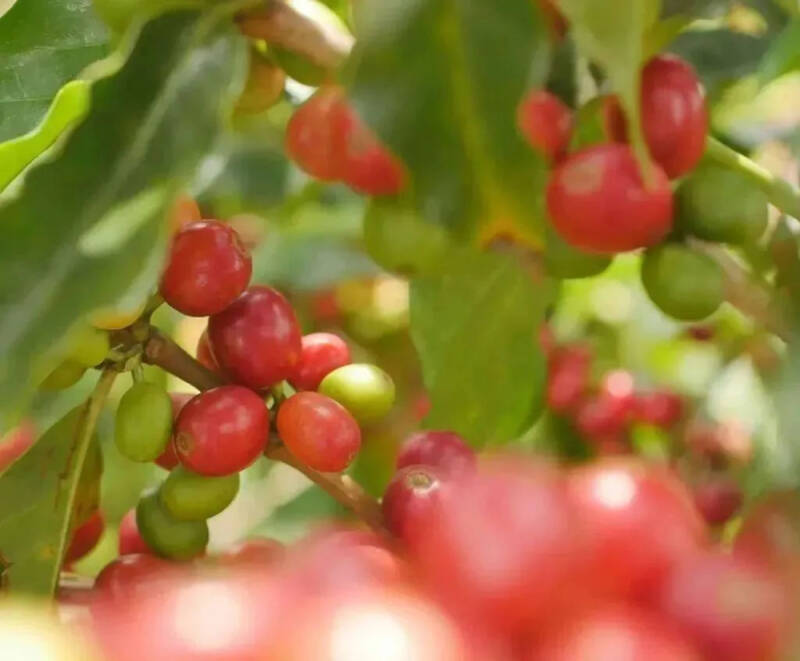How many common colors are there in the bourbon variety?
Among Arabica varieties, Typica and Bourbon are the most important and oldest coffee varieties in the world, but people will pay more attention to bourbon varieties because there are many color variations in bourbon varieties.

Speaking of bourbon, according to some records, this variety comes from Yemen and is a natural variety of iron pickup. In the early 17th century, it was introduced by French missionaries from Yemen to the Masklin Islands, 680 kilometers east of Madagascar. After the French occupied the island, the island was named Bourbon (French:. LeBourbon, now Reunion), and this batch of Yemeni coffee was also named bourbon.
In the 18th century, the island of Reunion became a nursery for the French to cultivate Yemeni bourbon coffee, until the mid-19th century, with missionary trips of French Holy Spirit missionaries, bourbon coffee was brought to Africa and South America.
When it was introduced to South America, Campinas was the first to arrive in southern Brazil, where tin pickup varieties were mainly grown, but the bourbon varieties were also susceptible to disease and insect pests, but the bourbon varieties were more productive, so they were planted in other parts of Brazil that expanded rapidly and gradually spread to other countries in South and Central America.
But later, with the development of the coffee industry, many coffee varieties have been bred through continuous transplantation, mutation and hybridization, so at present, in Latin America, most bourbon varieties are replaced by their varieties (Kaddura Caturra, Kaduai Catuai, New World Mundo Novo, etc.), only Brazil, El Salvador, Peru and other countries still have bourbon.

However, after the average coffee tree blossoms and bears fruit, the fruit color will change from green to yellowish, gradually to orange, and finally to red or more ripe crimson when ripe. However, bourbon varieties are special because after nearly a hundred years of breeding, bourbon varieties began to mutate, as well as color mutations, such as Yellow Bourbon, orange bourbon (Orange Bourbon) and pink bourbon (Pink Bourbon), while common bourbon species are also known as red bourbon for differentiation.
According to some records, Huang bourbon was first discovered in the 1930s on a bourbon-growing farm in Pederneiras, Sao Paulo, Brazil. Some people think it is a natural variety of red bourbon, but others say it is a natural breeding of red bourbon and "Amerelo de Botocatu (a variant of iron pickup with yellow fruit found in Sao Paulo in 1871)".
Later, the Brazilian Campinas Agricultural Research Institute (IAC) began to study the coffee and released several commercial varieties of yellow bourbon in the 1950s. Although yellow bourbon coffee ripens faster, its sweetness and aroma are more obvious than red bourbon, and it has obvious citrus acid, but its yield is lower than red bourbon, and its resistance to coffee disease is worse, so it is only grown in some areas of Sao Paulo, Brazil. On Qianjie Coffee, there are yellow bourbon beans from Queen's Manor in Mojiana, Sao Paulo, Brazil. After brewing, they will have sweet fruit, nutty flavors such as sugar cane, chocolate and peanuts, weak and clean bitterness, and a smooth and delicate taste.
Orange bourbon, originally found in El Salvador, is a natural mutation in the coffee fruit color gene, but it is sometimes easily confused with the Colombian "pink bourbon".
A relatively new variety has often appeared in Colombian events in recent years, and that is the pink bourbon, named after the light and soft pink color of the coffee fruit. At first, pink bourbon was hybridized with red bourbon and yellow bourbon to form a hybrid crystal, and the pink of its appearance is an invisible gene, and once it encounters red or yellow, dominant genes such as red or yellow will be masked and cannot be revealed. therefore, even if the variety has strong disease resistance, it is not easy to maintain a stable yield, and the yield is very low. It must be planted separately from other varieties to reduce the risk of being covered by other colors.
Although it was generally believed that pink bourbon was a bourbon species, genetic tests later found that pink bourbon was not only a bourbon gene, but most of the genes were similar to those of the Ethiopian native variety. therefore, it is not possible to determine the exact origin and true origin of the variety.
For more information about coffee producing areas, please scan the code directly and follow: coffee comments.
Long press the QR code to follow:
Important Notice :
前街咖啡 FrontStreet Coffee has moved to new addredd:
FrontStreet Coffee Address: 315,Donghua East Road,GuangZhou
Tel:020 38364473
- Prev

"Even being number one on the Shanghai Latte List won't stop me from closing the store."
▲ Click to pay attention| If the Daily Boutique Coffee Culture Magazine Coffee Workshop ranks domestic cities according to the intensity of coffee atmosphere, Shanghai, which has more than 9,000, will definitely rank among the top. In this bustling city, Shanghainese people's love for coffee goes without saying, and their unshakable habit has prompted the local coffee shop
- Next

The Ethiopian government added 40,000 new recruits! Large-scale exchanges of fire broke out in many places
According to Ethiopian media reports, the Ethiopian government has recently sent 40,000 troops to launch a new round of operations against Fano militants (Fano), which has led to very serious conflicts in many areas of Amhara State and has a serious impact on the economy and security of many regions of the country. It is reported that government security forces and
Related
- Why does hot American coffee taste bitter? Difference in proportional concentration between hot American and ice American
- Is espresso stored overnight in the refrigerator harmful to your body? Is frozen coffee better than freshly ground coffee?
- What parameters and proportions of water temperature should be used to grind and brew fresh coffee beans? Why can't I drink freshly roasted coffee right away?
- Customers have "changed" Manner's new products! Shop assistant: Please don't mess around!
- Remove sockets in customer areas at Starbucks stores?! Netizen: I won't go if I really tear it down
- What is the difference between the taste steps of sun-dried coffee and washed coffee? Why is sun-cured coffee sweeter and washed coffee sour?
- The recipe for salty grapefruit dirty is revealed! Coffee Festival salty grapefruit dirty coffee making materials parameters ratio milk share!
- How about the flavor of Sunlight 74158 at Sidamo Banshaha Mathieu Processing Factory in Ethiopia? 74158 Share the proportion of coffee brewing parameters!
- What effect does Italian American coffee with filter paper have? Will coffee taste better if it is put on filter paper at the bottom of the powder bowl?
- What is the color difference in coffee beans? What are the characteristics of honey processed coffee beans? Why are the anaerobically treated coffee beans uneven in color?

